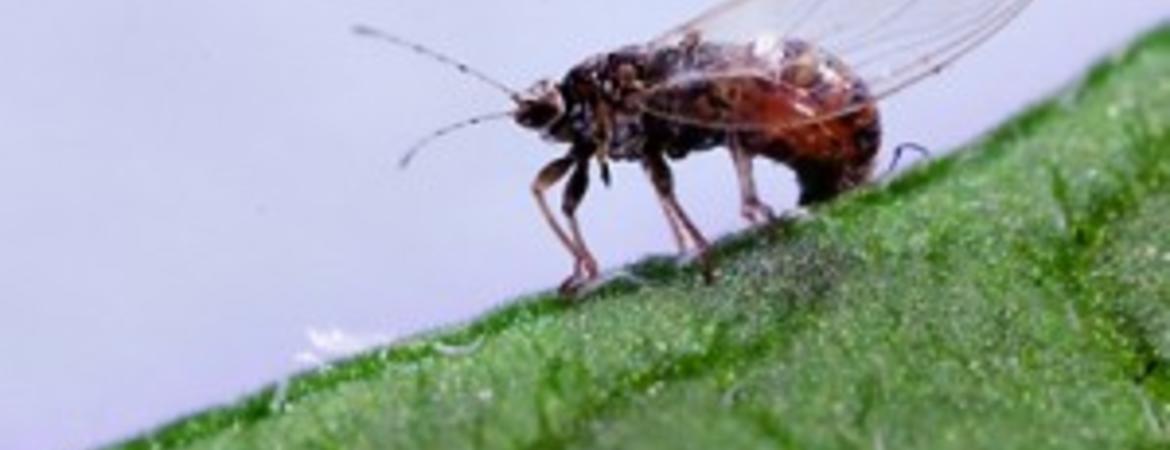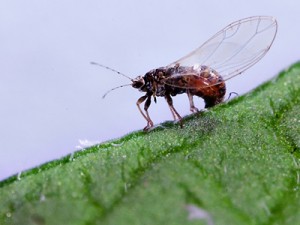
The Situation: The potato psyllid is a major insect pest of solanaceous crops growing in Central and North America. Potato psyllid has historically been a sporadic pest in California, generally developing damaging populations for 6 months or a year and then disappearing for 20 or 30 years. However, since the year 2000, year-round populations have been causing damaging outbreaks in California and Baja, Mexico. Increases in damage have been reported on potatoes and peppers throughout the Central USA. In addition, this pest has recently spread to Canada and New Zealand, where tomatoes, potatoes, and peppers have suffered significant losses.
Damage: Potato psyllid causes yield loss by directly feeding on crop plants causing a significant reduction in quality and crop longevity. Yield losses of greater than 85% have been reported in potatoes and tomatoes. These yield losses are now known to be associated with the transfer of a bacterial pathogen. In tomatoes, the pathogen causes stunted plants and very low yields of marketable fruit. A potato defect associated with the pathogen is known as “zebra chip” (ZC), and has been documented in commercial potato fields in the U.S. (Texas, Nebraska, Colorado, Kansas, New Mexico, Arizona, Nevada, and California), Mexico, and Guatemala. The disease was named for the characteristic discoloration in potato chips produced from infected tubers. The phloem tissues in the tubers store sugars instead of starches, and these sugars caramelize upon cooking. The occurrence of zebra chip not only lowers yields of the potato crop, but also results in the rejection of chips processed from infected tubers. In peppers, in California, damage occurs when large populations of potato psyllids produce exceptional amounts of honeydew, a sticky waste product, which contaminates the fruit. Why the pathogen causes losses in peppers in New Zealand and Texas, but not in California, is an important research question.
Economic Impact: The U.S. potato industry, a nearly $4 billion dollar crop in 2008, has been devastated by the appearance of ZC. Losses have been in the millions of dollars in Texas alone, and the insect and pathogen have spread to major production areas across the U.S. The economic losses are likely to increase as Korea, Argentina, and Brazil have established quarantine restrictions on U.S. potatoes to prevent the accidental introduction of the agent that causes ZC. Tomato growers in Baja California, Mexico lost 85% of their crop in 2001, and tomato growers in San Diego Co., CA lost 50% of their crops in 2003.
Distribution: Potato psyllid is native to central North America, but has been resident in California and Baja, Mexico since 2000. In the U.S., the potato psyllid has been reported from Arizona, California, Colorado, Idaho, Kansas, Minnesota, Nebraska, Nevada, New Mexico, North Dakota, Oklahoma, South Dakota, Texas, Utah, Washington and Wyoming. In Canada, potato psyllid is found in Alberta, British Columbia, Ontario, and Saskatchewan. This pest also occurs in Mexico and has been recorded in the following states: Baja California Norte, Chihuahua, Coahuila, Districto Federal, Durango, Guerrero, Jalisco, Michiocan, Morelos, San Luis Potosi, Sinaloa, Tamaulipas, and Veracruz. Recently, potato psyllids have been collected from Guatemala and it has established itself in most parts of New Zealand as a pest of solanaceous greenhouse crops, as well as outdoor potatoes and tomatoes.
Research: At the UC Riverside campus, research is being conducted in the context of developing an integrated pest management program against this pest. This research focuses identifying and determining the role of natural enemies on potato psyllid population dynamics, the relative resistance of fresh market and chipping potato cultivars, characterizing the amount of variation that exists for the bacterium that cause ZC in potato psyllid populations, identification of potential non-crop hosts and studies on the impact of pesticides on ZC transmission.
Want more? Go to the CISR website for more on the Potato Psyllid
